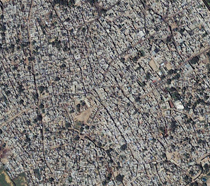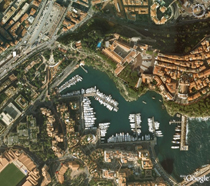2. Urbanisation
Urbanisation and policy responses
The process of urbanisation proceeds very differently and shifted in time in industrialised and developing countries. The European cities experienced the most intensive period of growth in the second half of the 19th century. Back then the growth was borne mainly by the gradual immigration of the rural population and less by birth surplus in the cities (with a high mortality rate).
Nowadays, the birth surplus plays the most important role in the developing countries. In addition, the growth of cities is twice as high as in industrial countries. Most of the immigrants head into the supposed attractive mega cities, in which in contrast to the emerging cities in Europe of the 19th century, only a low number of jobs are available.

Part of Agra, India.
Source: IKONOS Satellite Image provided by GeoEye and Satellite Imaging Corporation |

Part of Monaco.
Source: Google Earth |
The key difference to the metropolises of the West is the dynamic of growth. Secondly, the metropolitan infrastructure in cities in developing countries, was and is not, prepared for such an inrush (Bauer et al. 2005, Claaßen 2008).
When low skilled, poor migrants from rural areas move to urban areas, they become a new kind of proletariat with little to lose. The new arrivals are crowded together in overpopulated apartment buildings, dismal tenements, and teeming slums because housing cannot keep up with this massive inflow. Cities in the developing world additionally lack enforceable zoning laws. Zoning practices are often minimal, ineffective, or unenforced (De Blij, Murphy 2003, Dutt, Noble 2003).
The population growth especially in the core of the mega cities is generated by the lower class. This results in a permanent intra-urban process of aggregation, accompanied by marginalization of the population living in this area. The upper and middle classes however cause suburban growth (Bronger 2004).
The cities have nevertheless an unbroken attractiveness. "Even when the living conditions in the city are lousy, they are still better than the living conditions in the country" (Bauer et al. 2005).
Tasks: 1. Explain the basic differences of urbanisation in developing and industrialised countries.
2. Examine critically Third World governments' responses to the phenomenon of rural-urban migration (see table).
Policy responses to rural-urban migration in the Third World
| Policy approaches | Rationale | Types of policies and programmes |
| Negative | Emphasises the undesirability of migration and seeks to erect barriers to population movement and to forcibly 'deport' migrants | Closed city, pass laws, deportation, bulldozing of squatter settlements, enforced resettlement from urban to rural areas, registration system, employment controls, restricted access to housing, food rationing systems |
| Accommodative | Accepts migration as inevitable, and seeks to minimise the negative effects in both origin and destination places | Slum upgrading, urban job creation, labour-intensive industrialization, minimum wage legislation, urban infrastructural investment, improved social welfare, improvements in transportation |
| Manipulative | Accepts migration as inevitable and even desirable in some cases but seeks to redirect migration flows towards alternative destinations | Colonization, land settlement, land development, urban, industrial and administrative decentralization, information systems, management of contact networks |
| Preventive | Attempts to confront the root causes by tackling poverty, inequality and unemployment at source, and reducing the attractiveness of urban areas to potential migrants | Land reform, agricultural intensification, agricultural extension, rural infrastructure investment, rural industrialization, improving rural-urban terms of trade, reducing urban bias, propaganda in favour of the rural sector |
Source: Parnwell 1993, cited in Pacione 2001
